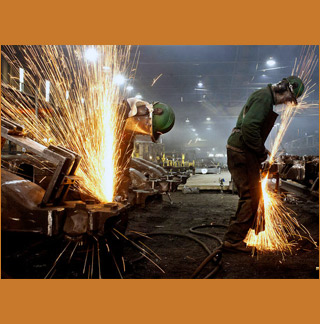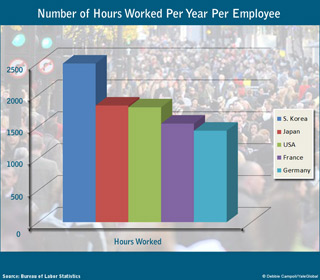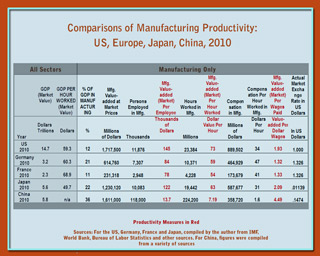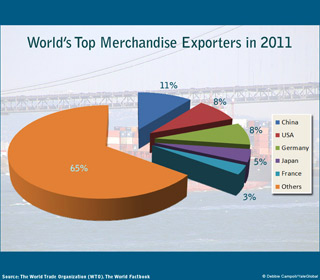7 Reasons to Expect US Manufacturing Resurgence
7 Reasons to Expect US Manufacturing Resurgence

NEWARK, NJ: Some 2.8 million American jobs – 70 percent of them in manufacturing – have been lost since 2001 because of the US trade deficit with China, according to a recent Economic Policy Institute study. Indeed, consumers visiting a Wal-Mart or Macy’s are hard pressed to find much made in America.
It’s true that the share of manufacturing in the US GDP is now only 12 to15 percent, and the country is predominantly a service economy. But the nation is still the world’s biggest manufacturer, with unrivaled productivity in terms of manufacturing value-added per employee or per hour worked (Table 1). American manufacturing wages average $34 an hour, some 21 times the average in China at $1.60 an hour. But each US worker adds $145,000 in value, far more than German, French or Japanese employees, and more than 10 times that of the Chinese worker who contributes $13,700.
The predominant explanation is US manufacturers' investment in automated equipment. Also, American labor is better trained than the Chinese. Similar productivity rankings can be seen in dollar value-added per hour: The US worker is on top with $73 in value-added per hour worked; the Chinese worker adds only $7.19 of value per hour; Japanese, German and French workers contribute up to $63. China outperforms the US and Europe only in “value added per dollar wages paid” – but only because hourly wages are so low in China.
Seven factors converging by 2012 suggest that US manufacturing could see a strong resurgence. Jobs once offshored are now returning in industries including automobiles and even unlikely areas like furniture and televisions.
> Wages of the bottom half of American workers have significantly declined in real terms over the past decade, as well as in comparison with other nations, while those of US manufacturing rivals, including China and Japan, have risen.
> American workers are working longer, faster, with greater anxiety, than ever before. Because of greater automation, flexibility, domestic US outsourcing and the fear of being laid-off, surviving US manufacturing workers have seen little or no increases in wages in the past eight years, and their output has increased with productivity in output per employee at an all-time high. Americans put in 1800 hours per year, about the same as Japanese workers (Table 2). Top is South Korea, with its corporate culture that prevents employees going home until the last boss has departed. The French and Germans, by comparison, put in 19 percent less time than Americans.
> The dollar has weakened against several major currencies over the past decade, making imports more expensive and producing in or exporting from the US more competitive, by comparison. The US is not just the world’s biggest importer but also the second largest exporter of merchandise goods (Table 3). In 2001 – the year China joined the World Trade Organization – the renminbi yuan, RMB, was 8.27 per dollar. By 2012 the currency had appreciated by more than 30 percent to 6.3 RMB per dollar. For many Chinese exporters, a breakeven exchange rate, when their exports to the US are no longer competitive, is between 5.5 to 5.8 yuan per dollar. As the RMB continues to appreciate against the dollar, more Chinese firms will abandon exports and focus on their domestic market, growing at 8 percent per annum.

> China is experiencing significant wage inflation. On the eastern seaboard, where most of China’s manufacturing takes place, several companies have experienced labor shortages and wage bills have increased by 20 percent per year.
> Fuel prices have more than doubled. For products with significant transportation costs, the rise in energy costs can add significantly to the cost of imports. Shipping large appliances is expensive, so Haier, a leading white goods manufacturer based in China, opened a South Carolina plant where components, shipped across the Pacific Ocean, are assembled by American workers.
> Delivery and Flexibility Pressures. For products requiring flexibility in the face of fickle fashion changes or assembly operations that require components shipped within a few days to accommodate schedules, such pressures have driven component producers to co-locate near US assembly operations.
> Natural disasters and disruptions in recent years have spooked global supply chains: Volcanoes in Iceland, overflowing rivers in Thailand and tsunamis in the Pacific Ocean idled assembly plants in the US and Europe because parts from affected regions could not be shipped. Years of cost savings at Toyota, from sourcing components from faraway locations, were wiped out by a few weeks of losses from assembly operations idled by 2011 floods in Thailand.
Of course, all indicators are not positive. Three factors could inhibit the US resurgence:
> The culture devalues science or engineering education. “Nerds,” “geeks” or “wonks” are at the bottom of the social totem pole compared to sports, film and media celebrities. A culture that emphasizes quick results and instant gratification deters students from tackling math, engineering and other challenging subjects.
> Too many students pursue a general college degree. According to a survey released by the Manpower Group in May 2012, talent shortages persist in skilled trades, engineers and IT staff, with “nearly half of U.S. employers struggling to fill mission-critical positions.” In OECD countries an average 23 percent of college degrees are in engineering, science or mathematics. But in the US such degrees comprise only 15 percent – and of these, foreign students earn a quarter of the degrees at the undergraduate level and some two-thirds at the doctoral level.
> US companies lack an apprenticeship system. In other OECD nations like Germany, alternative paths in education lead to diplomas or certificates in technical areas, with employees trained by the company in a particular technology and then retained in well-paying careers. Some US companies are trying this approach, highlighted by G. Bussey in an April Wall Street Journal article. For example, General Electric is sending new employees for crash courses in hands-on manufacturing or sponsoring two-week summer camps at universities on lean manufacturing for high-school students.
But don’t hold your breath. Few American companies are providing apprenticeships and only in selected areas of the country. Unlike Germany, the US is a very mobile society. The average household moves every five years. In an environment where companies can easily sack workers and where workers leave for better opportunities, firms are loath to invest in worker training, only to see skilled workers leave for competing companies. The current economic slowdown, which is reducing such churn in American society and jobs, could lead to a better appreciation for the benefits of apprenticeship programs for both companies and workers.
The time is propitious for a resurgence of manufacturing in the US. Unlike the exuberance of the bubble years, new economic conditions, which may persist for years to come, suggest more sober social attitudes, more career-focused college majors, more buckling down to learn harder subjects, less churn in jobs, and greater willingness to settle for somewhat lower wages in return for company investment in worker training and greater job security. In short, some aspects of the future may look like the old days when Detroit was king and skilled technical jobs meant reasonably secure careers with a moderate middle-class living standard.

